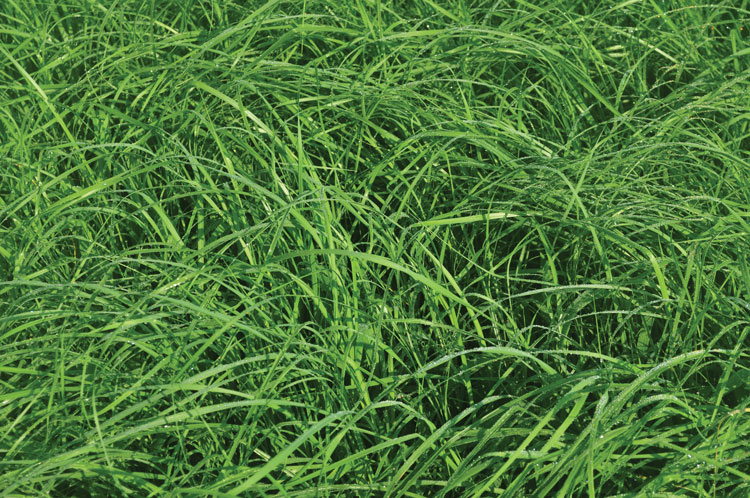
Teff grass is not as well known in the U.S. as other forage grasses. This is mainly because its distribution around the world was based initially on its use as a grain for human consumption. Only in recent years has it gained popularity as a forage resource.
It was after its initial introduction into the U.S. from Africa that researchers determined that teff also had potential as a forage grass. As a result, plant breeders in the last 20 years have released new teff varieties that have been specifically selected for forage production. Since those releases, teff has gained popularity among forage producers as a high-yielding and high-quality forage grass. The grass has also proven to offer numerous cropping options and production advantages.
A versatile option
Teff is an excellent emergency crop choice when adverse weather delays planting of grain crops beyond optimal planting dates. Teff can also be planted to provide supplemental forage in years where extreme winterkill has caused stand losses to perennial forages such as alfalfa. As a fast-growing, warm-season annual, teff can provide, under optimal growing conditions, 1 to 2 tons per acre of forage in 45 to 50 days.
Teff can provide summer forage to offset the lack of forage production of cool-season perennial grasses during their typical “summer slump” period. It can be planted from late spring to midsummer, making it an excellent double-crop choice following cereal grain crops such as wheat.
To avoid autotoxicity, alfalfa fields must be rotated out of alfalfa for at least one year following stand termination. Planting teff allows forage growers to produce a high-quality and high-yielding forage during the year they are rotating out of alfalfa.
During drought or restricted-water years, full-season irrigation may not be possible. In those situations, teff’s fast germination and vigorous growth facilitates the production of a forage crop where limited water is available. Generally, producers can expect reasonable forage production as long as there is adequate soil moisture at planting for germination and establishment.
In addition to the multiple cropping options, teff can also provide numerous production advantages that forage producers may want to consider. Its low seeding rate of 5 to 8 pounds per acre, combined with a moderate seed price of $3 to $4 per pound, makes the total seed cost per acre manageable.

A low-input alternative
Teff is adapted to multiple environments, ranging from drought-stressed to waterlogged soil conditions across numerous soil types. It is classified as a C4 plant, making it especially productive in hot, dry climates. In general, teff can be grown in any area that is currently growing corn or sorghum.
Considered a low-input crop, teff grass plantings following legumes or sod may not require any additional nitrogen fertilization for the first cutting. Seasonal nitrogen needs are relatively meager, generally in the range of 50 to 80 pounds per acre. In multiple cut locations, split applications of 30 to 50 pounds following each cutting can enhance overall yield. Moderate amounts of phosphorus and, in some cases, sulfur may be required.
As a warm-season annual, teff is well suited to provide supplemental forage during the summer months when other forages have underperformed or failed due to winterkill. Also, teff can provide additional quality forage during the “summer slump” period of cool season grasses. During drought-stress periods, teff has been reported to stay greener longer than other forages. Teff requires approximately 50% to 70% as much water as alfalfa to produce an economic crop.
When forage is needed in a short amount of time, teff is an excellent option. If planting occurs when soil temperatures are at least 65°F and warming, and there is adequate soil moisture, the first-cutting can be made in 45 to 50 days. Depending on the location and length of the growing season, teff can provide multiple harvests. Following the first cutting, established teff can be cut approximately every 30 to 35 days until frost.
Teff is best suited for haying operations; however established fields can be grazed by cattle, horses, sheep, and other livestock.
A premier horse forage
After teff was first introduced as a forage grass in the U.S., the initial market was targeted for horses. This was in part due to teff’s close comparison nutritionally to timothy, which is considered by many people to be the premier grass for horse hay (see Table 1).

Teff, due to its high forage quality and exceptional palatability, is considered by some producers as the warm-season crop equivalent to timothy. However, timothy is a cool-season grass and therefore limited in its production area. Teff’s advantage over timothy is that it can be grown in warmer climates while still achieving high forage quality. Teff is also considered to be relatively low in nonstructural carbohydrates, which is a characteristic sought out by many horse owners when purchasing hay.
In recent years, teff has also caught the attention of dairy nutritionists who want to add more grass into the dairy ration. Teff is known to have exceptional palatability and high animal acceptance, making it desirable in a dairy ration. This, combined with its high summer yield and high forage quality, has given teff a foothold in the dairy market, and it is gaining traction. It is also being utilized by other livestock species, including beef cattle, sheep, and goats. Prussic acid or nitrate toxicity in teff forage has not been observed in late-season grazing or after a frost.
Many factors go into the decision of what crop best fits a forage producer’s operation. Producers may want to seriously consider teff’s desirable agronomic and nutritional benefits as a component of the overall forage enterprise. The marketability of teff grass continues to expand.
This article appeared in the November 2023 issue of Hay & Forage Grower on page 22.
Not a subscriber? Click to get the print magazine.

